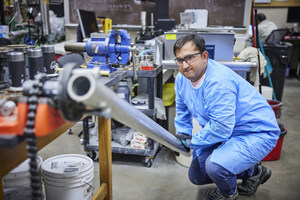NORMAN, Okla., March 22, 2022 /PRNewswire/ -- The University of Oklahoma has received funding from the National Institutes of Health to establish the Oklahoma Center of Medical Imaging for Translational Cancer Research. Bin Zheng, Ph.D., a professor and Oklahoma TSET Cancer Research Scholar in the Gallogly College of Engineering's School of Electrical and Computer Engineering, is leading the new center.
Medical imaging is an essential tool to help doctors and scientists assess the size and scope of a tumor that will be effectively removed by surgery, as well as the rate at which tumors shrink in response to medical interventions such as chemotherapy or radiation therapy. University of Oklahoma researchers are investigating multiple avenues to help improve medical imaging use in cancer detection, diagnosis and treatment.
"While there are other kinds of testing methods, like blood testing, imaging is the most commonly used by clinicians," Zheng said. "The problem is that reading medical images by radiologists is quite difficult because tumors, cancer and most diseases are very heterogenous – there is a lot a variation. We often see different image diagnostic results from different clinicians or different hospitals because of the large inter-reader variability, which can result in applying different treatment options and potentially reduce treatment efficacy."
To counter this challenge, the center's researchers are developing quantitative imaging markers to provide an objective measure or index that can reduce subjectivity and improve consistency for medical image diagnosis using two primary types of research approaches.
The first approach is to develop new investigative cutting-edge imaging modalities to expand ability of doctors to see or detect more detailed tumor internal structures such as using the advanced optical imaging modalities and technology.
The second is to explore and extract more effective image features from the existing clinical imaging modalities – like CT, MRI and X-ray images – and then using artificial intelligence or machine learning models to develop new quantitative imaging markers to help reduce subjectivity and variability of cancer diagnosis and predicting cancer prognosis.
The award from the Centers of Biomedical Research Excellence (COBRE) program of the NIH is expected to provide more than $11.3 million over a five-year Phase 1 period, with the opportunity to compete for renewal for up to three phases. The first phase supports the center's establishment to galvanize multidisciplinary biomedical research through equipment and facilities support to junior faculty.
The center is beginning with four projects currently underway. Three projects are led by faculty in the Gallogly College of Engineering and one by a clinician scientist at the Stephenson Cancer Center. All four projects will include close collaboration between engineering researchers from the OU Norman campus and clinician scientists from the OU Health Sciences Center campus to promote interdisciplinary and translational cancer research. Learn more about these projects at ou.edu/research. Photos are available via Dropbox.
SOURCE University of Oklahoma

WANT YOUR COMPANY'S NEWS FEATURED ON PRNEWSWIRE.COM?
Newsrooms &
Influencers
Digital Media
Outlets
Journalists
Opted In





Share this article